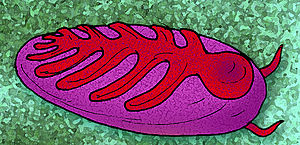Vendia (animal)
| Vendia | ||||||||||
|---|---|---|---|---|---|---|---|---|---|---|

Paravendia janae , Vendia sokolovi and Vendia rachiata |
||||||||||
| Temporal occurrence | ||||||||||
| Ediacarium | ||||||||||
| 558 to 555 million years | ||||||||||
| Locations | ||||||||||
| Systematics | ||||||||||
|
||||||||||
| Scientific name | ||||||||||
| Vendia | ||||||||||
| Keller , 1969 | ||||||||||
| species | ||||||||||
|
||||||||||
Vendia is an extinct animal genus of the Ediacariums , which belongs tothe Proarticulata tribe (or to the clade Bilateriomorpha ).
etymology
Vendia was named after the Vendium , an Eastern European geological sequence of the late Neoproterozoic . The stage of the Vendium in turn relates to the Slavic tribe of the Wends .
Discovery and first description
The taxon Vendia sokolovi was discovered in a core of a borehole driven into the Valdai series (area of Jarensk , southern Arkhangelsk Oblast ) at the beginning of the 1960s and was first described scientifically by Boris Keller in 1969.
description
The taxon Vendia , which belongs to the Ediacara fauna, has an oval shape and is between 4.5 and 12.5 millimeters long. The body is completely subdivided into so-called isomers , which are arranged along the body axis in two mutually offset rows. The transverse isomers steadily decrease in length towards the end of the tail and all follow the same angle of inclination to the body axis. The larger isomers cover the outside of the smaller isomers, only the ends remain free and are uncovered.
Vendia has a longitudinal furrow, which is interpreted as a digestive system, consisting of an axial tube and short lateral processes between the isomers. With the exception of the first isomers in Vendia rachiata , all isomers have a lateral extension.
Taxonomy
The genus Vendia includes two taxa:
- Vendia sokolovi cellar, 1969
- Vendia rachiata Ivantsov, 2004
Vendia sokolovi is only documented by one find. The taxon is 11 millimeters long and has 7 segments on each side.
Vendia rachiata differs from Vendia sokolovi in that it has fewer segments. The 12.5 millimeter long taxon has only 5 segments per side. The segment length decreases rapidly towards the tail end. In addition, the lateral processes are shorter than in Vendia sokolovi . Vendia rachiata is only known from the site on the Solsa ( Verkhovka Formation of the Upper Vendian, Onega Peninsula , Arkhangelsk Oblast).
The former taxon Vendia janae has now been added to the new genus Paravendia . It differs from the genus Vendia in the configuration and the relative arrangement of its isomers, which bend back so far that they meet at the tip of the tail. Larger isomers completely cover the smaller ones. The site is Simnije Gory on the eastern White Sea coast .
The genera Vendia , Paravendia and probably also Karakhtia belong to the family of Vendiidae , which in turn is assigned to the class of Vendiamorpha and the tribe of Proarticulata . The taxon Pseudovendia charnwoodensis from the Charnwood Forest near Leicester is either attributed to the Charnia fossil belonging to the Rangeomorpha or even viewed as a pseudofossil.
Individual evidence
- ^ BM Keller: Imprint of unknown animal from Valdai Series of Russian Platform (in Russian) . In: AY Rozanov et al., "Tommotian Stage and the Cambrian lower boundary problem" (Ed.): Geol. Inst. Trans. Band 206 , 1969, pp. 175 .
- ^ A b Ivantsov, AY: New Proarticulata from the Vendian of the Arkhangel'sk Region . In: Paleontological Journal . tape 38 (3) , 2004, p. 247-253 .
- ^ A b Ivantsov, AY: Vendia and Other Precambrian "Arthropods" . In: Paleontological Journal . tape 35 (4) , 2001, p. 335-343 .
- ↑ Serezhnikova, EA and Ivantsov, AY: Fedomia mikhaili - a spicule-bearing organism of sponge grade from the Vendian (Ediacaran) of the White Sea, Russia . In: Palaeoworld . tape 16 , 2007, p. 319-324 .
- ^ MA Fedonkin: Systematic Description of Vendian Metazoa . Ed .: Sokolov, BS and Iwanowski, AB, "Vendian System: Historical-Geological and Paleontological Foundation, Vol. 1: Paleontology". Nauka, Moscow 1985, p. 70-106 .
